R.I.P. Expanding Universe (b. 1930, d. 2012):
(The Big Bang never happened)
David Noel
<davidn@aoi.com.au>
Ben Franklin Centre for Theoretical Research
PO Box 27, Subiaco, WA 6008, Australia.

The Expanding Universe theory is Dead!
The Expanding Universe theory is Dead, struck down by a single simple fact. The proof is so simple that it can be stated in one paragraph, without using a single formula.
The Expanding Universe idea had, at its basis, observations by Edwin Hubble that the wavelengths of light from distant galactic objects were shifted towards the red (lower energy). This was interpreted by some as being due to the objects receding from an observer on Earth (Doppler Shift). If this was true, the shift should be the same for all wavelengths of the light emitted from a distant object. It is not true. So, red-shifting cannot be due to recession, and does not mean that the Universe is expanding.
What is the Doppler Shift?
The Austrian physicist and mathematician Christian Doppler was the first to point out how the sound given out by a moving object appeared to alter in pitch as it moved toward or away from the listener. This is the NYEEEEOOOWWWW sound you notice when a car drives quickly past.

Figure RIP1. Plaque on the wall of the house in Salzberg, Austria, where Doppler was born.
The effect happens because sound is transmitted by waves, and if the object emitting the waves is moving towards or away from you, the waves are compressed or stretched a little.

Figure RIP2. Wave frequency change in the Doppler effect. From [1].
The frequency of a wave is the number of oscillations in unit time, and if movement leads to a listener receiving more waves in unit time, this is perceived as a higher frequency or pitch.
There is a similar effect with the light received from distant stars or galaxies. If they are moving away from us their light is stretched and moved toward the redder, lower-energy end of the spectrum.
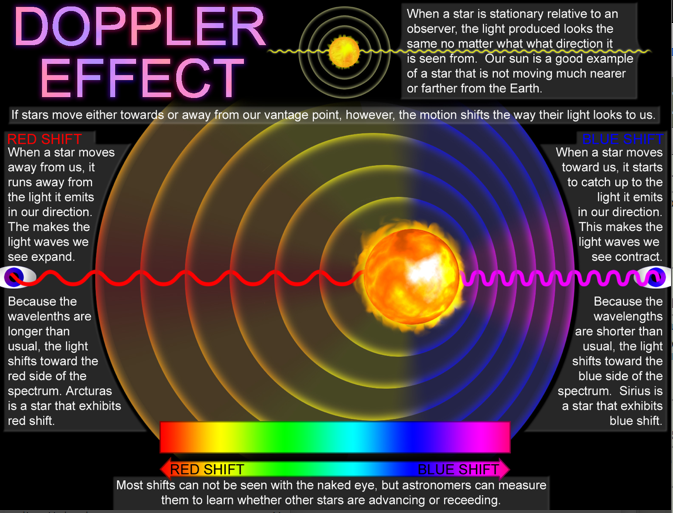
Figure RIP3. The Doppler Effect altering the frequency of light from stars. From [4].
So measuring the Doppler shift of a nearby star is a good way of determining if it is moving relative to the Sun and Earth -- even the nearest star system to ours is so distant, that movement of the Earth round the Sun makes no significant difference. As noted in Figure RIP3, the star Arcturus shows a red shift, and is moving away from us, while Sirius is actually getting closer, and so its light has a blue shift.
These astronomical measurements are made by measuring the shifts in spectral lines, these are dark bars across a star's spectrum because certain frequencies are absorbed by particular atoms before the light reaches us. There is a nice YouTube animation [2] which explains more.
All this is pretty standard and not at argument. The thing which gave rise to a huge and enduring misconception was the way the red-shift measurements made by Edwin Hubble were interpreted, and this led to quite shaky speculations that the Universe was expanding.

Fig. RIP4. Edwin Hubble (1889 - 1953). From [5].
Edwin Hubble was an astronomer working in California, where he had the opportunity to use new, larger, telescopes, which were able to see further into the Cosmos, beyond our home Milky Way galaxy. Hubble observed that the light from these more distant galaxies was subject to red shifting, and that this red shift was greater, the further away a galaxy was (distances could be independently estimated from the apparent brightness of certain stars which had an intrinsic brightness). This relationship between red-shift and distance became known as Hubble's Law.
Red-shift and distance were linked as Hubble's Constant, which is still a basic item of astronomical apparatus. This Constant is not an exact scientific value, more a working rule of thumb (quoted values vary by over 5.6%, for reasons which will become evident).
In the early days of red-shift work, the idea that it was due to Doppler shifting was only one of the explanations put forward. Another idea was that it was due to Gravitational Red Shift (GRS), where light was losing energy (just like a solid object) as it passed through the complex of gravitational fields between source and observer.
Gravitational Red Shift is currently accepted as the cause of several astronomical effects, such as gravitational lensing. In the early 1930s, when explanations of red shift were still fluid, Fritz Zwicky showed that GRS gave a better explanation of red-shifting than did Doppler [6].
Edwin Hubble himself never accepted that red-shifting was due to expansion, although popular astronomy works often mistakenly say that he did. In an early article [5], Engelbert Broda had this to say:
"It could also be that, according to a -- so far not yet discovered -- law of physics, every beam of light over long periods of time, i.e. when it hurries through long stretches, decreases in frequency and therefore, little by little, becomes redder. As the energy of a beam of light is the smaller the redder the light is, this would, at the same time, mean that light, over the course of millions of years, loses energy. The light from the farthest galaxies would have lost the most energy, so that the redshift would be explained. The astronomer who has contributed to the measurement of the redshift more than any other scientist -- Edwin Hubble -- tends to this view."
Even so, over the intervening years since the 1930s, the expansion theory gradually became the dominant paradigm, and GRS as a cause of red shift was pushed to one side. A fuller look at this interesting phenomenon can be found in the companion article The Placid Universe Model [6].
The Big Bang fallacy
Armed with (erroneous) numbers on rates of expansion, it was not long before cosmologists thought to try and calculate backwards to see how long ago expansion had started, assuming that the whole Universe started off as a single point, and had somehow expanded enormously to its present state. Dubbed "The Big Bang", this 'point at the beginning of time' was calculated as about 13.7 billion years ago.
So the whole Big Bang fallacy is essentially based on the belief that red-shifting of light was due to Doppler expansion of the Universe. Hence, if it can be proved that red-shifting is not due to Doppler expansion, the whole vast edifice of the Expanding Universe and the Big Bang Theory just collapses in a heap.
Of course, astronomers and physicists have invested enormous amounts of research and whole careers on the Expanding Universe theory, building up mountains of data and library-size stores of publications, so they are not going to quietly accept any sort of proofs. Instead, back to the trenches, and fight to the last man!
Scientists like formulas
It's been explained above, as a commonsense thing, that red shifts from a single source must be exactly the same for all parts of its spectrum (all its frequencies), if they truly reflect motion away of the object. If these single-object red shifts in fact vary with wavelength (technically called wavelength dispersion), which they do, they cannot be a consequence of relative motion.
Sometimes the relevant formula can explain a position better. Here is the formula for astronomical red shifts.
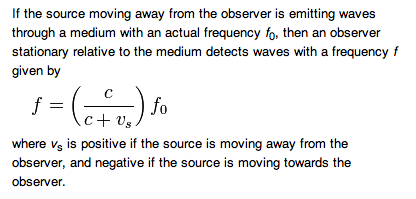
Fig. RIP5. Doppler red shift for light. From [3].
As formulas go, this one is fairly simple. It says that the apparent frequency observed from a source moving away from you is the original frequency, multiplied by a ratio. This ratio is the speed of light, over the sum of the speed of light plus the speed of recession.
Notice that this formula doesn't contain any term for the wavelength of the light; the red shift is independent of the wavelength, if it is due to the Doppler Effect.
In fact, measurements of red shifts from distant galactic objects show that they do vary with wavelength (they show dispersion). This variation has been measured, and is actually used by astronomers to confirm that all relevant parts of a spectrum they are looking at are from the same object.
Here is a question, and an answer very kindly supplied by NASA Astrophysicist Hans Krimm.
Q. Have any checks been made of the spectra of red shifts from very distant
galactic objects, to see if the red shift varies with wavelength? I am aware
that current Doppler theory says there should be no dispersion, I would like to
know if this theory is borne out by actual measurements, preferably of distant
objects for which wide spectra are available (radio to x-ray).
A. There have been redshift measurements made for many distant galaxies across a wide spectral band (though mostly in the optical to infrared) and a consistent redshift with wavelength has been found. In fact, this is one of the ways in which astronomers confirm that the spectral shifts they are seeing are redshifts -- the same delta-wavelength/wavelength is measured for multiple spectral lines.
I don't know what the current limits are on such dispersion, but I found a 1956 paper which showed a change in redshift with wavelength of 3 X 10^-9 per 1000 Angstroms. [Reference 7 below, a paper by Minkowski and Wilson].
So there it is. The proof that the Universe is not expanding (and hence that there was no Big Bang) is contained in a routine paper published in a respected journal, over 50 years ago.
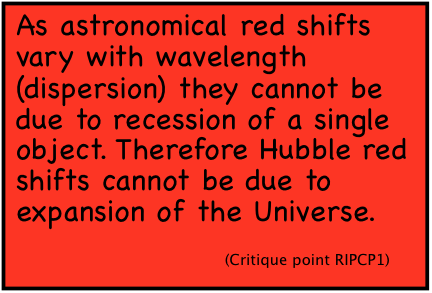
Critique point RIPCP1
Why wasn't this point picked up earlier?
This is interesting. Here is an extract from the Minkowski paper.
Since the discovery of the nebular red shift, its wave-length dependence has been investigated at various times. The result of these investigations has always been that the red shift is proportional to wave length, as is to be expected if the shift is due to a Doppler effect caused by a recession of the galaxies.
It all seems very reasonable. You are measuring red shifts, you think to investigate whether they vary with wavelength. Well look, they do. As they are due to a Doppler effect, that is "as is to be expected". And the red shifts are nicely proportional to wavelength.
Scientists like nice formulas, here is something which fits to a formula. Sadly, sadly, the physical circumstances behind the formula are forgotten. So a misconception is propagated and built on, more and more grandly. After enough time, even someone who noticed the flaw would be reluctant to go up against the massed Status Quo.
And it's not just a matter of needing to set the record right. People not actively involved in producing publications on science have no concept of the 'scientific cleansing' apparatus built up, perhaps unconsciously, to keep upstart critics well outside the pale.
Ridicule and derision about new ideas, not blessed by 'peer review' is normal. I have had a submitted scientific paper rejected for its 'motivation' [8]. Among the far more serious things which can occur, are loss of tenure, or sidetracking to a career dead-end, or even dismissal.

For this reason, those incautious enough to want to expose an establishment-threatening new concept have had to work outside the electrified fences. When Edwin Hubble was completing his pioneer work on red shifts, publication of this work was bitterly opposed by powerful figures in the field. Despite the opposition, Hubble, then a thirty-five-year-old scientist, had his findings first published in The New York Times newspaper (on November 23, 1924) [5].
In the Cosmology section of his book [16] about how science has developed, Dick Teresi says: We don't know what the Babylonians thought about members of their society who disagreed with the consensus cosmology. Were they tolerated? Tortured? We know in our own time that scientists who do not endorse the Big Bang are committing professional suicide".
So if it's not Doppler, then what?
Distant galactic red shifts are a natural consequence of the effects of gravity on light passing through gravitational fields (Gravitational Red Shift, GRS). This is not in dispute. The following extract is from [6], in which can be found the relevant references.
The concept that light is red-shifted when subjected to a gravitational field is not disputed at this time. For example, the phenomenon is described in Stephen Hawking's book "A Brief History of Time", and has been confirmed with various satellite experiments. In a way, GRS in radiation is only the analogue of momentum loss in matter under gravity. If you try to fire the shell from a large gun into space, it has to battle gravity to rise, and has to expend energy to do this. This loss of energy is expressed in a slowing of the shell's rate of rise as it climbs.
In the same way, if you shine a laser searchlight into space, the beam actually loses a little energy as it rises through the Earth's gravitational field, although the effect is so tiny that it would normally not be noticed. But it does happen. And since the speed of light is fixed, the energy loss can only be expressed by moving the light to a lower-energy (redder) wavelength.
In Fritz Zwicky's original paper, GRS is explained as a consequence of relativity theory, and specifically for the case of a light quantum passing a body with mass. He gives a formula for calculating the red shift, and shows it is in general agreement with measurements of globular clusters in our own galaxy. The biggest GRS effects are likely to be noticed where light is rising out of a very deep gravity well, that is, directly away from a very large mass. An example is light coming from a supermassive black hole.
So we know that light is affected by gravity. We also know that the behaviour of a ray of light is affected by its wavelength.
Newton's Prism
The English genius Isaac Newton was responsible for the creation of Optics as a scientific subject (it was called Opticks in his day). One of his demonstrations showed how the behaviour of light is affected by its wavelength -- this involved passing a beam of ordinary white light (from the Sun) through a prism. The prism splits the light up according to its wavelength (colour).

Fig. RIP6. Newton's prism experiment. From [9].
This factor is a problem for the manufacturers of camera and other optical lenses. Lenses are generally used to bring light to a focus, and because normal light is a mixture of different wavelengths, the focus point is slightly different for different colours -- technically it's called chromatic aberration. The lens manufacturers need to use special techniques to counter this.
The gravitational lensing effect, by which distant stellar fields are 'lensed' into multiple images by massive intergalactic objects, is well known to astronomers. So GRS, Gravitational Red Shift, is just another aspect of the physics.
There is also a gravitational approach to everyday optics, like the prism effect noted above. Transparent objects such as glasses have a characteristic called Refractive Index, which is a measure of how much light is bent when it enters such an object from air or space. Refractive Index is directly dependent on the speed of light in an object, itself varying with the object's density.
So, for example, a glass containing a lot of lead, which has dense atoms, will have a high refractive index, and light travels more slowly through lead glass than through ordinary soda glass. A lens made of lead glass will have more refractive power than a similar one made of ordinary glass.
Down at the crystal lattice level, where a solid is treated as arrays of individual atoms, individual light packets (photons) can be looked as as moving under the influence of the gravity exerted by the arrays of atoms they are passing through. There is a nice animated model of this at The Photon Hoop Model for light [10] which gives a visual feel for what is happening.

Fig. RIP7. Light packets travelling through a crystal lattice.. From [10].
Where do the theoretical physicists stand?
It can be seen that the theoretical background virtually requires there to be a Gravitational Red Shift theory. Light comes to us from very distant sources, to reach us it has to pass through huge gravitational-field set-ups, sitting around stars and galaxies. And because gravity will affect radiation in proportion to its intrinsic energy, the linear dispersion of red shift with wavelength is only to be expected.
Note that this is true whether or not huge Doppler red shifts exist or not. So, GRS does not require Doppler and an expanding Universe, but an Expanding Universe theory based on Doppler must still account for GRS. It doesn't.
It can be helpful to see the situation as a diagram. Every gravitational source, every mass, has the potential to affect and red-shift any photon stream, any light beam, passing within its influence. In the diagram following, the loss of energy suffered by light originating from a source such as a massive star is shown to increase, gradually or steeply, as the light passes through galaxies on its route towards us.

Fig. RIP8. Light accumulating red shift during passage through the Universe.
Does it really matter, anyway?
OK, so the Expanding Universe and Big Bang theories fall in a heap -- does it matter to the scientific world? Or to the everyday world?
Yes it does. Caught up in the Big Bang paradigm, astronomy and the allied sciences have fetched up against the railway buffers at the end of the line. Research investigations which have assumed the Expanding Universe concept as a given, have been going down a dead end and wasting enormous amounts of effort and funds.
When the Red Shift was taken as indicating a speed of recession, it yielded a single number as that speed, there was nothing further to investigate. When the Red Shift is taken as the result of gravitational fields, as in Fig. RIP8, it is part of a multi-dimensional situation within which valuable research can proceed.
Look again at the figure, light starts off on the left arising from a source such as a massive star, or maybe a nova. To escape from its source, the light has first to fight its way up through the source's own gravity well.
This aspect is ignored in the old Doppler science, that tells us nothing about the gravity of the source star or galaxy. With the new GRS viewpoint, more detailed red-shift analysis may tell us much about the source.
In particular, the old Doppler view may be the cause of skewed results for the distances of far objects. The most distant objects are only detectable because they give out a lot of light. Such objects are typically very massive, with huge gravitational fields. So calculations on visible very distant objects done without taking source-gravity-wells into consideration are likely to give results which are too large, because the gravity-well energy loss is mistakenly converted into extra speed of recession.
Of course, gravity-well energy loss is not neglected as a topic, just usually treated quite separately from the red-shift usually ascribed to Doppler. For those wanting more detail, the topic is discussed in [12].
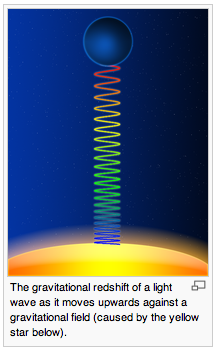
Fig. RIP9. Gravitational redshift diagram. From [12].
What's the position with the Hubble Constant?
There are two quite separate issues here. Hubble's original assertion, that more distant light-emitting bodies have greater red shifts, holds. But when the position is quantified, giving numerical values to the relationship, there are difficulties in both accuracy and meaning.
As to accuracy, there is no argument but that the Hubble "Constant" is only a rule-of-thumb constant, serving to indicate how far away a distant galaxy may be, rather than a definable scientific quantity capable of being precisely determined.
So on this count, the "Constant" is a fairly useful number telling us how far away an astronomical object is. Red shifts do give a rough indication of this distance, whether interpreted as loss of energy due to gravitation (GRS) or Doppler (Expansion).
The Expansion concept is barren for further research, it gives a single number, expressed as a speed. GRS is capable of much refinement, essentially by evaluating and summing the effects of gravitational fields, as in Fig. RIP8 (in concept, the area under the purple curve represents the GRS value).
 .
. 
Fig. RIP10. Hubble's Constant data. From [14].
Figure RIP10 shows red-shift plotted against distance for some objects. Clearly the values don't do much more than allow a trend line to be drawn. The horizontal (Distance) axis is marked in Mpc, megaparsecs, and is OK (1 megaparsec is 3.09 × 1019 km, about 3.26 million light-years).
But the vertical (Red-shift) axis is not OK. It is marked in km/sec, a speed value, and so the actual red-shift (basically a frequency shift noted on spectra) has already been wrongly converted to a speed by assuming it represents an object speeding away from us.
Then there is the question of accuracy and reliability. The notation used for Hubble's Constant is H0. In [14] it notes that "As of 3rd Oct 2012 the Hubble constant, as measured by NASA's Spitzer Telescope and reported in Science Daily, is 74.3 ± 2.1 (km/s)/Mpc". Let's accept H0 as a number defining a distance, without worrying too much here about its units. NASA's value is 74.3 ± 2.1, that is, in the range 72.2 to 76.4, an uncertainty of 5.8%.
The text on the right of Fig. RIP10 gives other estimates for H0, one a range of 65 to 77 (uncertainty 18%), another a range of 57.3 to 67.3 (uncertainty 17%), so just these 2 figures represent a range of 57.3 to 77, an uncertainty of 34%. Clearly red-shift gives no more than an indication of distance, and must be compared with distances derived from other independent methods to get sense from the situation.
Using the "z" value for red shift
Another way of representing red-shift is based on the frequencies or wavelengths of light, as originally emitted and as observed by a distant observer. The quantity "z" is defined by various alternative, but equivalent, formulas (Fig. RIP11).
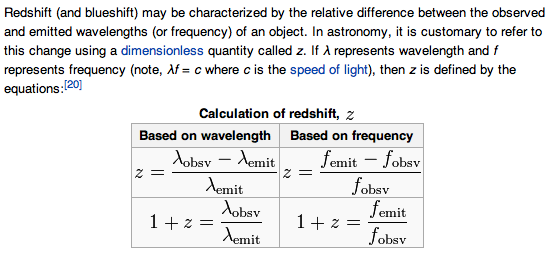
Fig. RIP11. Red-shift "z" formulas. From [11].
The value of "z" will always be positive for red shifts. Closer objects have "z" just a little above zero, more distant objects will have z = 1 and above.
Notice that these formulas inherently make the assumption that red-shifts for a single object will vary with wavelength, else the value of "z" would itself vary for the same object. This is the same error which conflicts with physical reality, in that different parts of a single object cannot move at different speeds.
The largest red shifts measured are those of the quasars, stars which intrinsically emit huge levels of radiation and hence can be detected at great distances. Measurements of more than 100 quasars have given "z" values ranging from 0.16 to 3.53 [14].
Using the same erroneous assumption of a relationship between red-shift and speed of recession in an expanding Universe, "z" values may be represented as expansion speeds. The quasars noted above have been worked out to have recession speeds of 0.15c to 0.91c [14], that is 15-91% of the speed of light.
A 2011 reference [15] says that "pushing the Hubble Space Telescope to the limit of its technical ability, an international collaboration of astronomers have found what is likely to be the most distant and ancient galaxy ever seen, whose light has taken 13.2 billion years to reach us (a redshift of around 10)." Reference [14] has a little calculator to convert "z" to a percentage of the speed of light. For z=10, this gives 98.36% of c, the speed of light.

Fig. RIP12. Most distant celestial object found, as of 2011. From [15].
All the stuff put out about the most distant objects and their characteristics must be subject to re-examination in the light of the present proof that red-shifts do not show that the Universe is expanding. The now disproved Big Bang Theory placed the 'beginning of the Universe' back around 13.7 billion years, pretty close to the age of the distant galaxy at 13.2 billion years.
A comprehensive body of evidence that the Big Bang never happened is available in the companion article The Placid Universe Model [6]. This evidence is derived from various technical and non-technical considerations. But the most cogent item is the simple observation that light from the Universe of 10 billion years and older simply does not give a picture which the Big Bang theory would imply, a picture of a Universe which was once highly compressed compared to now. Instead, the picture is of a Universe similar in general appearance and properties to now. Figure RIP12 above is typical of the picture obtained of much closer parts of the Universe, with no sign of huge compression.
Quite apart from the present point of contention, ever-improving astronomical instruments and methods must soon lead to a crunch point, where more distant objects are logged as generating light from over 13.7 billion years ago, before the alleged beginning of the Universe. Look forward to a range of amazingly ingenious fudge factors from the older experts!
"That new-time religion" -- where to from here?
So, here is the proof that the Big Bang never happened, the Universe is not expanding, it didn't all come from a single point some 13.7 billion years ago. What are the prospects for general public acceptance of this, and for 'scientific consensus'?
The answer is, don't hold your breath. If 'science' worked by pure rationality, as many fondly believe, it might happen quickly. But when it comes to cosmologies, whether ancient or modern, these are intricately tied up with religions. The Church of The Big Bang is no different.
Cosmologist Edward Harrison notes [18] that "Our universe is the only rational universe. Ones that came before us are mythologies. Contemporaries who disagree with our cosmology are crackpots." He calls cosmology "that new-time religion".
When it comes to TV series, I have to admit that among my biggest favourites is "The Big Bang Theory". But I don't have any difficulty in remembering that this, too, is fiction.

* * * * * * * * * * * * * * * * * * * * *

References and Links
1. Illustration of the Doppler Effect. http://www.gulfofmaine-census.org/wp-content/images/Technology/doppler1L.jpg .
2. Spectrum of the Stars. http://www.youtube.com/watch?v=l4yg4HTm3uk&feature=related .
3. The Doppler Effect. http://en.wikipedia.org/wiki/Doppler_effect .
4. Doppler effect.. http://zewex.blogspot.com.au/ .
5. Edwin Hubble.. http://en.wikipedia.org/wiki/Edwin_Hubble .
6. David Noel. The Placid Universe Model -- Why the Universe is NOT Expanding, or, The real origin of CMBR, Cosmic Microwave Background Radiation. http://www.aoi.com.au/bcw/Placid/index.htm .
7. R Minkowski and O C Wilson. Proportionality of Nebular Red Shifts to Wave length. Astrophysical Journal, May 1956, pp. 373-376. Internet: http://adsabs.harvard.edu/full/1956ApJ...123..373M .
8. David Noel. A new model for the origin of Cosmic Microwave Background Radiation. http://www.aoi.com.au/scientific/SciCMBR/ .
9. Colours Of The Rainbow. http://www.spiritualwisdom.org.uk/colours-of-the-rainbow.htm .
10. David Noel. The Photon Hoop Model for light. http://www.aoi.com.au/bcw/PhotonHoop/index.htm
11. Redshift. http://en.wikipedia.org/wiki/Redshift .
12. Gravitational Redshift. http://en.wikipedia.org/wiki/Gravitational_redshift .
13. Hubble's Law. http://en.wikipedia.org/wiki/Hubble_constant .
14. Red Shift. http://hyperphysics.phy-astr.gsu.edu/hbase/astro/redshf.html .
15. Hubble finds a new contender for galaxy distance record. http://www.spacetelescope.org/news/heic1103/ .
16. Dick Teresi. Lost Discoveries: the ancient roots of modern science, from the Babylonians to the Maya. Simon and Schuster, 2002.
17. Edward Harrison. Masks Of The Universe. Macmillan, 1985.
Stablemate articles:
The Placid Universe Model -- Why the Universe is NOT Expanding, or, The real origin of CMBR, Cosmic Microwave Background Radiation At: http://www.aoi.com.au/bcw/Placid/index.htm .
The Photon Hoop Model for light. At: http://www.aoi.com.au/bcw/PhotonHoop/index.htm .
Go to the BCW Home Page
Draft Versions, 1.0-1.3, 2012 Oct 21-Nov 4. V.1.4, first draft up on web, 2012 Nov 5.
V.1.5, 2012 Nov 7-9.














 .
. 



